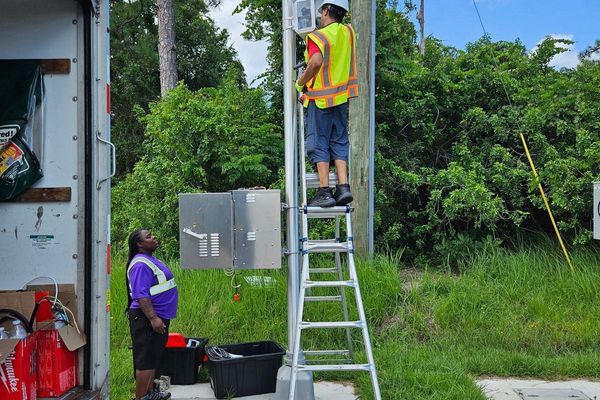BP reported mixed first-quarter earnings early Tuesday, narrowly missing revenue estimates. Meanwhile, U.S. oil prices tanked, bringing energy stocks down during market trade, amid recession concerns.
When OPEC+, the oil cartel bolstered by allies such as Russia, announced a surprise oil production cut in early April, oil prices spiked to five-month highs. From there, it was unclear which way oil would go. Some analysts predicted a recession would sap pricing strength. Others forecast strong oil demand and increased prices.
BP's earnings Tuesday follow reports from U.S. oil majors Chevron and Exxon Mobil and top oil field service firms. However, none have done much to clarify this year's outlook for oil.
BP Jumped 20% After Trimming Climate Targets — A Black Eye For ESG Investing?
So far in 2023, oil and natural gas prices have dropped considerably vs. the 2022 levels that drove sky-high profits for oil producers.
U.S. crude oil futures dropped more than 5% to below $72 per barrel Tuesday, hitting five-week lows on concerns about impending interest rate hikes. Oil dipped as low as $66.74 in March. U.S. oil futures hit a five-month high $83.38 per barrel on April 12 following the news from OPEC+, which includes the Organization of the Petroleum Exporting Countries and key allies.
The April 2 announcement cut the group's production quota by 1.15 million barrels a day starting in May. The oil cartel had previously signaled it would hold supply steady throughout 2023. In October, OPEC+ cut output by 2 million barrels per day.
Analysts saw this as a proactive move by OPEC, responding to concerns of a recession hurting oil demand in 2023. The Street took the move as reaction to the risk of a disappointing reopening of China's economy and a possible recession in the U.S.
BP stock sank 8% Tuesday during market trade. Shares are poised in a consolidation with an early entry at 40.80 and a standard buy point at 41.48.
Meanwhile, Chevron stock dipped 4.3% and Exxon Mobil slumped 4%. SLB, formerly known as Schlumberger, edged down 6% Tuesday. Halliburton dove 8.2% and Baker Hughes eased down 5.3%.
Energy Giants Report Falling Revenue
Analysts predicted BP first-quarter EPS would drop 28% to $1.38 with revenue growing 15% to $56.84 billion.
BP reported Tuesday earnings falling 13% to $1.66 per share in Q1 as revenue grew 14% to $56.18 billion. The company predicts oil prices will be "elevated in the second quarter as the recent decision by OPEC+ to restrict production, combined with strengthening Chinese demand, tightens supply/demand balances."
BP's operating cash flow dropped 7% to $7.62 billion. The company's surplus cash flow decreased 43% to $2.28 billion in Q1. BP repurchased $2.45 billion in shares in the first quarter, up from $1.6 billion a year ago but down sequentially from $3.24 billion in Q4.
BP said it will repurchase a further $1.75 billion in shares in Q2, down from the $2.75 billion plan for Q1. The company said it "remains committed to using 60% of 2023 surplus cash flow for share buybacks."
Meanwhile, BP also plans for reported and underlying upstream production in Q2 to be broadly flat compared with 2022.
Ahead of BP earnings, Ed Yardeni, chief investment strategist for Yardeni Research, said in an interview that U.S. oil prices were stable in the first quarter until the OPEC+ production cut.
"Even that didn't seem to really lead to a sustainable rally in the oil market," Yardeni said. "It looks as though the price of oil is going to be stuck around the current levels for a while, reflecting the global economy that's just growing but certainly not booming. Nor is it falling into a recession."
Phil Flynn, senior analyst at the Price Futures Group, added in a note Thursday that oil demand has not been affected by recent bank failures and that oil prices could fall.
"If oil goes south, I think OPEC will act," Flynn wrote.
BP: Chevron And Exxon Report Financials
With oil prices dropping from 2022 levels, Chevron and Exxon Mobil topped Wall Street estimates for first-quarter financials Friday. However both companies saw revenue slip compared to a year ago, as the two U.S. majors come off booming profits last year.
Chevron reported earnings up 6% to $3.55 per share in the quarter as sales dropped 6% to $50.79 billion. The California-based company said the profit increase was primarily due to higher margins on refined product sales, which were partially offset by lower upstream realizations.
Worldwide net oil-equivalent production dropped 3% to 2.98 million oil-equivalent barrels per day in Q1. Chevron said this was due to lower international production.
The company also announced capital expenditures totaled $3 billion in the first quarter, up 55% vs. a year ago on the back of "higher investment" in the U.S.
Meanwhile, Exxon Mobil earnings jumped 36% to $2.83 per share with revenue declining 4% to $86.56 billion. The company's first-quarter net production was 3.8 million oil-equivalent barrels per day, up 4% from last year.
However, Exxon Mobil's upstream earnings totaled $6.5 billion in the first quarter, a 20% drop compared to the fourth-quarter 2022, but a 45% jump from last year. The company said the main driver of this sequential quarterly drop was lower prices, with crude and natural gas realizations down 10% and 23%, respectively.
CFRA analyst Stewart Glickman told IBD Friday he does not see Exxon Mobil or Chevron chasing production growth in 2023, choosing instead to focus on shareholder returns. Glickman said this will push oil prices higher.
Will Summer Driving Season Boost Oil Prices?
Driving season is upcoming in the U.S., a time when crude prices usually increase. However, oil prices and gasoline do not appear to be increasing yet this year.
The price of gasoline at the pump averaged $3.60 per gallon Tuesday, down 14% compared to last year, according to the AAA.
"As long as the oil cost keeps wobbling around the low to mid $70s per barrel, drivers will benefit when they fuel up," Andrew Gross, an AAA spokesperson, said in a statement Thursday.
U.S. crude futures this summer are estimated to hover between $74 and $76 per barrel, according to CME Group. Crude prices are estimated to drop to between $72 and $74 per barrel in the waning months of 2023.
Glickman said his best guess is U.S. crude futures will be around $75 to $80 per barrel on average. That's down from average U.S. crude prices of $95 per barrel in 2022, according to Glickman. But it could include some price spikes and dives.
"I would absolutely not be surprised if we had a lot of volatility along the way," Glickman said.
Yardeni added it's still early to see the effect of the summer driving season on oil prices.
"We need to get into late May and June to see the seasonal effects," he said. "It looks like Americans are still itching to travel, whether it be in the U.S. by car or flying."
"That's likely to be a positive for oil prices, as is the production cut by OPEC," Yardeni said.
Meanwhile, U.S. natural gas prices Tuesday were around $2.43 per million British thermal units. Natural gas futures undercut the $2 mark in late February 2023 for the first time since September 2020. Natural gas prices have declined 78% from their August 2022 peak of $10.
Stocks Skid As Banks Dive, Fed Looms; AMD Falls Late On Guidance
BP: Oil Field Service Firms Upbeat
Oil field services and equipment firm Halliburton recently reported above-forecast Q1 earnings. The firm was the latest to post target-topping reports, after SLB and Baker Hughes.
Going into 2023, Baker Hughes, SLB and Halliburton all projected strong oil demand and tight supplies for the foreseeable future. Each oil field services leader also pointed to myriad international growth opportunities, especially in the Middle East.
Halliburton reported earnings ballooning 106% to 72 cents per share. Revenue grew 33% to $5.68 billion in Q1. Revenue from "completion and production" in the first quarter increased 45% to $3.4 billion.
Halliburton CEO Jeff Miller told investors the outlook for 2023 and beyond is "strong."
"We hear it from our customers, and we see it in our first-quarter results. Our customers are clearly motivated to produce more oil and gas and service capacity is tight," Miller said.
It's All About OPEC+
SLB EPS soared 85% to 63 cents while revenue ramped up 30% to $7.74 billion. The company's well construction and production systems revenue increased 36% and 38%, respectively.
SLB CEO Olivier Le Puech said pricing trends were positive. Customers are working to adjust contracts to offset inflation, according to the CEO.
Le Puech added that service capacity continues to tighten across international markets.
"There is broader recognition of the positive long-term demand outlook for oil and gas and the potential for a stronger demand rebound in the second half of the year," Le Peuch said.
"Recent OPEC+ decisions continue to keep commodity prices at supportive levels — providing operators increased confidence to execute their projects," he said.
BP ranks second in IBD's Oil & Gas-Integrated industry group. Shares have a 91 Composite Rating out of 99. BP stock has a 93 Relative Strength Rating, an exclusive IBD Stock Checkup gauge for share-price movement. The EPS rating for BP is 75.
Please follow Kit Norton on Twitter @KitNorton for more coverage.







